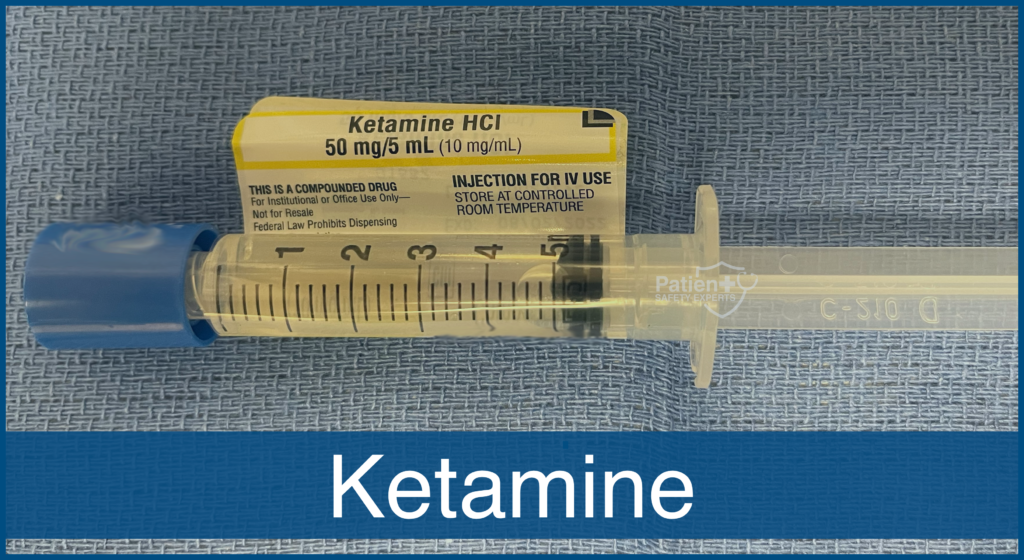Ketamine has seen an explosion in use as part of a multimodal analgesic regime as well as for treating chronic pain and depression. While generally regarded as safe, there are some patients for whom Ketamine usage may be detrimental.
What is Ketamine?
Ketamine is a dissociative anesthetic used by anesthesiologists for surgery as well as in veterinary medicine.
History of Ketamine
Calvin Lee Stevens, Ph.D., a professor of organic chemistry at Wayne State University, was a chemical consultant to Parke-Davis. At that time, Parke-Davis was searching among cyclohexylamines for an ‘ideal’ anesthetic agent with analgesic properties.
Stevens synthesized a unique series of phencyclidine derivatives in his laboratory. One of the compounds, synthesized in 1962, produced excellent anesthesia and was short-acting. It was selected for human trials as CI-581 [2-(O-chloro-phenyl)-2-methyl-amino cyclohexanone],1, and because it was a ketone together with an amine, was named ketamine (Fig. 1).

As he was not an anesthesiologist, Stevens called his colleague Dr. Corssen, a professor in anesthesiology at the University of Michigan, who was interested in intravenous anesthetics. The first human administration was conducted by Dr. Corssen and Dr. Edward Domino on 3 August 1964 to volunteer prisoners at the Jackson Prison in the state of Michigan.(2). Domino et al. (3) published the first clinical studies in 1965.
Corssen and Domino observed that patients described their feeling of floating in outer space and having no feeling in their limbs.1 Domino spoke to his wife Toni about the fact that patients seemed to be ‘disconnected,’ and she suggested the term ‘dissociative anesthetic.’1 This is how Ketamine came to be described as a “dissociative anesthetic.”
Dissociative anesthesia was later described as the electrophysiological and functional dissociation between thalamocortical and limbic systems.
Ketamine was officially patented by Parke-Davis for human and animal use in 1966 and became available by prescription in 1969 in the form of ketamine hydrochloride under the name of Ketalar. It was approved for human consumption by the United States Food and Drug Administration in 1970 and saw a surge in use as a field anesthetic administered to soldiers during the Vietnam War.
Uses of Ketamine
Ketamine has many different uses in Anesthesiology dating back to its discovery during a search for the ideal anesthetic agent.
The most common uses today include:
- as a dissociative anesthetic for minor procedures in the emergency department
- as a multi-modal adjunct for general anesthesia
- as an induction agent for general anesthesia
- Treament for depression
- Treatment for chronic pain
Learn more about Anesthetic Induction agents
References
- Domino EF. Taming the ketamine tiger. 1965. Anesthesiology. 2010 Sep;113(3):678-84. doi: 10.1097/ALN.0b013e3181ed09a2. PMID: 20693870.
- Dundee JW. Twenty-five years of ketamine. A report of an international meeting. Anaesthesia. 1990 Feb;45(2):159. doi: 10.1111/j.1365-2044.1990.tb14287.x. PMID: 2181889.
- DOMINO EF, CHODOFF P, CORSSEN G. PHARMACOLOGIC EFFECTS OF CI-581, A NEW DISSOCIATIVE ANESTHETIC, IN MAN. Clin Pharmacol Ther. 1965 May-Jun;6:279-91. doi: 10.1002/cpt196563279. PMID: 14296024.
- Juraj Sprung, Shannon M. Schuetz, Robert W. Stewart, Christine S. Moravec; Effects of Ketamine on the Contractility of Failing and Nonfailing Human Heart Muscles In Vitro . Anesthesiology 1998; 88:1202–1210 doi: https://doi.org/10.1097/00000542-199805000-00010











